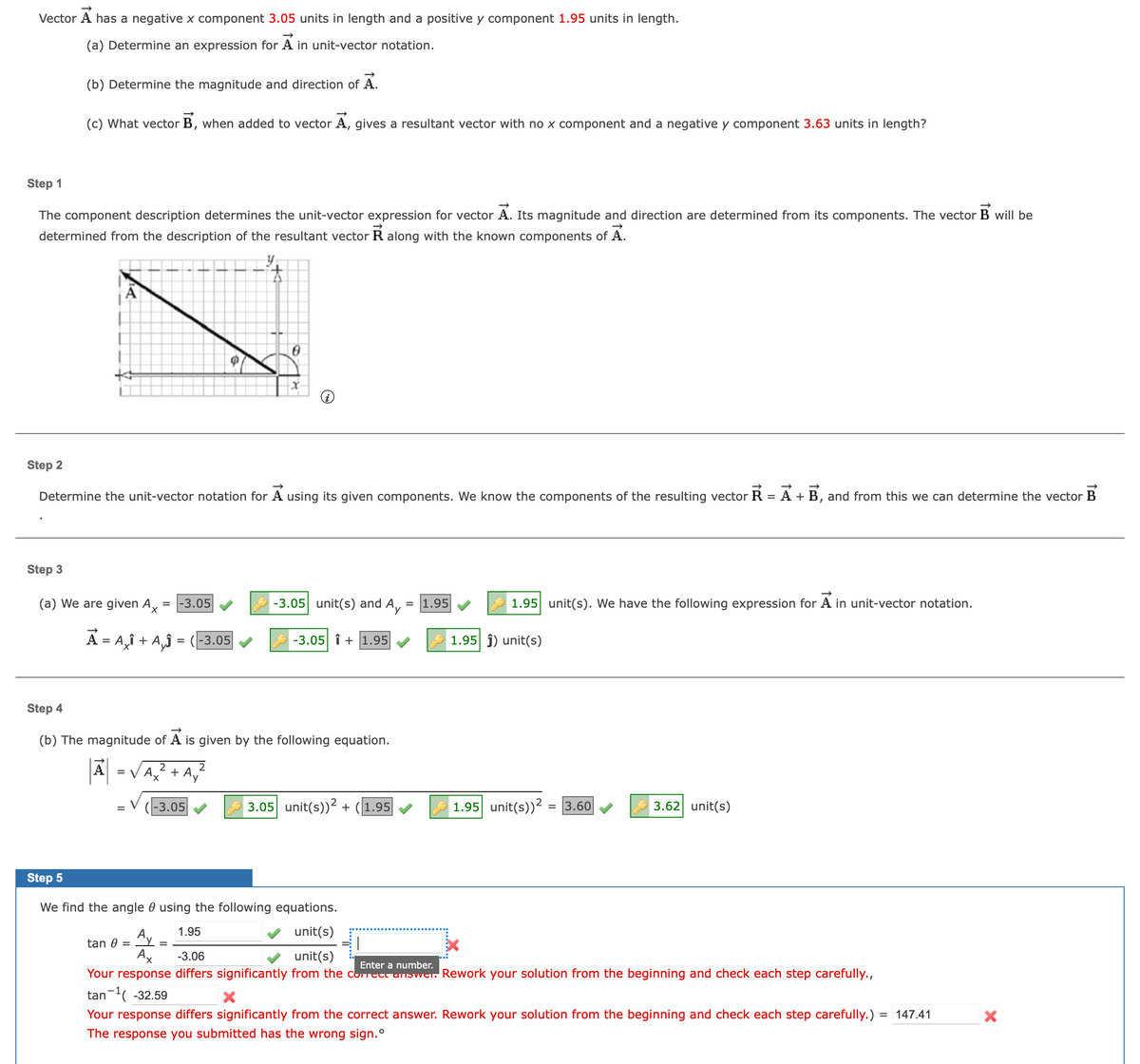Vector A has a negative x component 3.05 units in length and a positive y component 1.95 units in length. (a) Determine an expression for A in unit-vector notation. (b) Determine the magnitude and direction of A. (c) What vector B, when added to vector A, gives a resultant vector with no x component and a negative y component 3.63 units in length?
Vector A has a negative x component 3.05 units in length and a positive y component 1.95 units in length. (a) Determine an expression for A in unit-vector notation. (b) Determine the magnitude and direction of A. (c) What vector B, when added to vector A, gives a resultant vector with no x component and a negative y component 3.63 units in length?
Physics for Scientists and Engineers with Modern Physics
10th Edition
ISBN:9781337553292
Author:Raymond A. Serway, John W. Jewett
Publisher:Raymond A. Serway, John W. Jewett
Chapter3: Vectors
Section: Chapter Questions
Problem 21P: Vector A has a negative x component 3.00 units in length and a positive y component 2.00 units in...
Related questions
Question

Transcribed Image Text:Vector A has a negative x component 3.05 units in length and a positive y component 1.95 units in length.
(a) Determine an expression for A in unit-vector notation.
(b) Determine the magnitude and direction of A.
(c) What vector B, when added to vector A, gives a resultant vector with no x component and a negative y component 3.63 units in length?
Step 1
The component description determines the unit-vector expression for vector A. Its magnitude and direction are determined from its components. The vector B will be
determined from the description of the resultant vector R along with the known components of A.
Step 3
(a) We are given Ax
A = A
Step 2
Determine the unit-vector notation for A using its given components. We know the components of the resulting vector R
=
A + B, and from this we can determine the vector B
A
Axî + A,ĵ = (-3.05
= -3.05
=
=
€
-3.05
0
Step 4
(b) The magnitude of A is given by the following equation.
2
A₂²2² + Ay²
X
X
1.95
-3.05 unit(s) and Ay = 1.95
-3.05 +1.95
3.05 unit(s))² + 1.95
Co
1.95 unit(s). We have the following expression for A in unit-vector notation.
1.95 ĵ) unit(s)
1.95 unit(s))² = 3.60
3.62 unit(s)
Step 5
We find the angle using the following equations.
tan 0 Y =
Av
Ax
unit(s)
unit(s)
-3.06
Enter a number.
Your response differs significantly from the correct answer. Rework your solution from the beginning and check each step carefully.,
tan ¹(-32.59
Your response differs significantly from the correct answer. Rework your solution from the beginning and check each step carefully.) = = 147.41
The response you submitted has the wrong sign.º
X
Expert Solution
This question has been solved!
Explore an expertly crafted, step-by-step solution for a thorough understanding of key concepts.
Step by step
Solved in 2 steps with 2 images

Knowledge Booster
Learn more about
Need a deep-dive on the concept behind this application? Look no further. Learn more about this topic, physics and related others by exploring similar questions and additional content below.Recommended textbooks for you

Physics for Scientists and Engineers with Modern …
Physics
ISBN:
9781337553292
Author:
Raymond A. Serway, John W. Jewett
Publisher:
Cengage Learning

Principles of Physics: A Calculus-Based Text
Physics
ISBN:
9781133104261
Author:
Raymond A. Serway, John W. Jewett
Publisher:
Cengage Learning

Physics for Scientists and Engineers: Foundations…
Physics
ISBN:
9781133939146
Author:
Katz, Debora M.
Publisher:
Cengage Learning

Physics for Scientists and Engineers with Modern …
Physics
ISBN:
9781337553292
Author:
Raymond A. Serway, John W. Jewett
Publisher:
Cengage Learning

Principles of Physics: A Calculus-Based Text
Physics
ISBN:
9781133104261
Author:
Raymond A. Serway, John W. Jewett
Publisher:
Cengage Learning

Physics for Scientists and Engineers: Foundations…
Physics
ISBN:
9781133939146
Author:
Katz, Debora M.
Publisher:
Cengage Learning

University Physics Volume 1
Physics
ISBN:
9781938168277
Author:
William Moebs, Samuel J. Ling, Jeff Sanny
Publisher:
OpenStax - Rice University

College Physics
Physics
ISBN:
9781305952300
Author:
Raymond A. Serway, Chris Vuille
Publisher:
Cengage Learning

Glencoe Physics: Principles and Problems, Student…
Physics
ISBN:
9780078807213
Author:
Paul W. Zitzewitz
Publisher:
Glencoe/McGraw-Hill